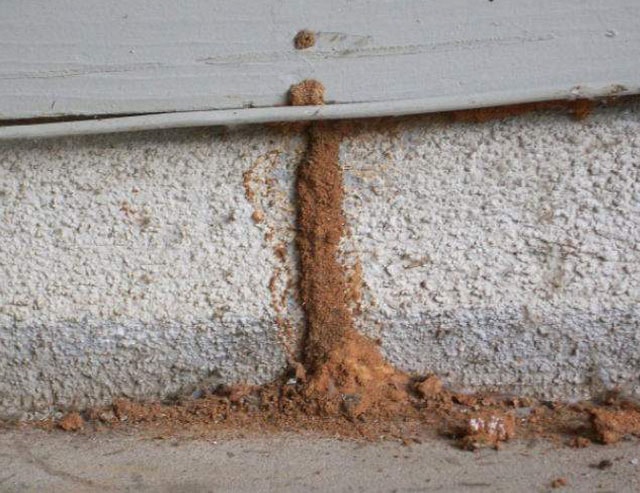Termites are an exceptionally destructive pest. A colony can quickly threaten the overall integrity of your home and cause significant structural damage. One of the tell-tale signs of an infestation is the presence of termite tubes, thin tunnels of mud-serving as a pathway from the insect colony to their food source.
However, you might be thinking what are termite tubes, and how do you go about finding them and dealing with them? In this blog, we will explore how termites work and provide you with helpful tips for protecting your home. If you suspect that your home has termites, call Drake Lawn & Pest Control for a termite inspection in Orlando.
What is a Termite Mud Tube?
Termites instinctively shelter themselves while they work, to protect themselves and gain sustenance for their colony while mitigating risks. There are several reasons why they build these functional structures out of saliva, waste, and nearby dirt.
- To avoid natural hunters
- To maintain moisture levels by remaining in the soil
- To obtain food in otherwise difficult places
Moisture is a must for subterranean pests like termites and being hidden from predators is a significant benefit of using the tubes for foraging for food. Bypassing manmade obstacles is made much easier by crafting the tunnels to go over or around anything standing between them and the wood they require for consumption.
These tunnel like structures don’t adhere to solid surfaces like wood beams or the foundation of your home. Termite tubes are surprisingly durable and can be free-standing. Termites will often use free-standing tubes to reach wood beams in your attic.
What Are Termite Tubes Called?
These tubes are basically small tunnels located right around the termite nests. They are also called termite mud tunnels or exploratory mud tubes, and are in fact made of mud and other debris around the nests to give the termites a pathway between their nest and a food source.
These mud tunnels are also meant to protect the termite colonies since they need to maintain their humidity to survive. Made from fecal matter, dust, and debris, these tubes keep the termites in the perfect environment.
You might see some different types of tubes. For example, there are working tubes that help transport the termites, but there are also exploratory tubes that are thinner and more fragile, and which can be around 15 feet above ground. These are the types of tubes that are usually abandoned by the time you find them, but when you do find them, you still need to call a professional.
Do Termite Tubes Mean You Have Termites?
Termite tubes are used by termites as a transportation kind of pathway from the soil to the wood of your home. If you see something that looks like a little muddy tube traveling towards your home or across your walls, it’s pretty much guaranteed that you have a termite infestation.
Look for them around any exposed surfaces, since they can appear anywhere around your home. Under your flooring or behind your siding are common areas, although it can be difficult to notice them in these cases. When you do notice them, yes, you do need to call a professional for help clearing them.
What Do You Do if You Find a Termite Tube?
Termite tubes are thin tunnels of mud made by termites. This means that if you see a termite tube, you unfortunately have a termite infestation. Termites are so destructive to your home that you need to work quickly—but wait! Don’t just try to swipe it away or even get too close.
Those termite tubes probably look pretty unusual, and since it’s made of dust or debris, your first instinct might be to just get rid of it. You have to resist the urge to move it, though, because moving these tubes can lead to termites migrating to other parts of your home. You need to call a professional to make sure both the tubes and termites are gone.
Should I Remove a Termite Tube?
If the termites tubes are dry and crumble on contact, then the termites may have moved on. However, even if it’s dry, there is no guarantee they are gone. Dried-out tubes may indicate that the termites used that tube as a point-of-entry and are now elsewhere inside your home.
Active tunnels will still have busy termites present, or at the very least still, be damp. Removing any or all parts of a termite tube will not eradicate the threat. It’s essential to keep in mind that the tunnels only serve as an outward symptom of a much larger issue beneath the surface.
Now, you might be tempted to just sweep those tubes away and think that you’ve dealt with the termite infestation. Well, it sadly doesn’t work like that. Termites will just relocate if you remove the tubing, but you would just no longer see them for a while as they silently cause damage to your home.
This is why your best bet is to leave those tubes so that our professional exterminators can take a look at them. That’s because, to actually make sure all those termites are gone, exterminators need to see exactly where the termites have gone and where the nests might be located around your house. Getting rid of those tubes just makes their job harder, which might lead to a higher cost and a longer infestation for you in the end.
Here’s the bottom line. When you see termite tubes, that’s the time for you to call in the experts here at Drake Lawn & Pest Control. Dry or not, tubes indicate termite activity of some kind. Termites are fond of re-colonizing, even if all the former colonists have been removed from your property. You will need to take an active stand in defending your home against these annoying invaders.
In terms of how a professional might handle these tubes, they might be able to set up a liquid barrier or pesticides to draw in the termites, but this isn’t something you should do yourself. If you handle the infestation improperly, this might lead to you just extending the problem, making it more costly for your home.
How Should You Address the Problem of Termite Mud Tubes?
Regardless of whether the tunnels are in active use or not, if you discover termite tubes around your house, the best thing you can do is call in a professional to inspect and diagnose the situation. Here in Central Florida, those professionals are found at Drake Lawn & Pest Control. Contact us today to schedule your termite inspection and finally be rid of those pests for good.
Brandon is the President of Drake Lawn and Pest Control in Orlando, FL . He has over 30 years experience in the Orlando Pest Control Industry. He attributes his achievements to living by these rules: continuous training and education, providing honest work and striving for the pursuit of perfect service.



